Basic tutorial: Interpolating bands, Berry curvatures, and integrating them
In this tutorial we will see how to compute band energies, Berry curvature, spins and anomalous Hall conductivity using WannierBerri code and further integrate them over the Brillouin zone to obtain Anomalous Hall conductivity, and other quantities of interest.
Preparation of a calculation:
import the needed modules
initialize a Parallel() or Serial() class
[1]:
# Preliminary
# Set environment variables - not mandatory but recommended if you use parallel with maximum number of CPUs
#import os
#os.environ['OPENBLAS_NUM_THREADS'] = '1'
#os.environ['MKL_NUM_THREADS'] = '1'
import ray
ray.init(num_cpus=8)
2025-11-20 05:16:31,151 INFO util.py:154 -- Missing packages: ['ipywidgets']. Run `pip install -U ipywidgets`, then restart the notebook server for rich notebook output.
2025-11-20 05:16:34,354 INFO worker.py:1918 -- Started a local Ray instance. View the dashboard at http://127.0.0.1:8265
[1]:
| Python version: | 3.12.12 |
| Ray version: | 2.48.0 |
| Dashboard: | http://127.0.0.1:8265 |
[2]:
import wannierberri as wberri
print (f"Using WannierBerri version {wberri.__version__}")
import numpy as np
import scipy
import matplotlib.pyplot as plt
%matplotlib inline
Using WannierBerri version 1.6.1
Reading the system
Now we need to define the system that we are working on. Wannierberri can equally work with Wannier functions obtained by Wannier90 or other code (e.g. ASE or FPLO), as well as tight-binding models. This is done by constructing a System() class or one of its subclasses. Below, an example for Wannier90 is given; in advanced tutorials, some tight-binding models are also used.
[3]:
# Importing data from wannier90
system=wberri.System_w90(
seedname='w90_files/Fe',
berry=True, # needed to calculate "external terms" of Berry connection or curvature , reads ".mmn" file
spin = True , # needed for spin properties, reads ".spn" file
)
# Setting the pointgroup from the symmetry operations
import irrep
spacegroup = irrep.spacegroup.SpaceGroup.from_cell( real_lattice=system.real_lattice,
positions=[[0,0,0]], # only 1 Fe atoms at origin
typat=[1], # atomic number is not important here
spinor=True,
magmom=[[0,0,1]], # magnetic moment along z
include_TR=True, # include symmetries that flip the spin
)
system.set_pointgroup(spacegroup=spacegroup)
# generators=["Inversion","C4z","TimeReversal*C2x"]
# system.set_pointgroup(symmetry_gen=generators)
Reading restart information from file w90_files/Fe.chk :
Time to read .chk : 0.014049530029296875
----------
SPN
---------
reading w90_files/Fe.spn : Created on 7May2022 at 16: 2:47
----------
SPN OK
---------
setting Rvec
setting AA..
setting AA - OK
Real-space lattice:
[[ 1.4349963 1.4349963 1.4349963]
[-1.4349963 1.4349963 1.4349963]
[-1.4349963 -1.4349963 1.4349963]]
Number of wannier functions: 18
Number of R points: 113
Recommended size of FFT grid [4 4 4]
Interpolation on a path
[4]:
# Evaluate bands, Berry curvature, and spin along a path GHPNG
# all kpoints given in reduced coordinates
path=wberri.Path(system,
nodes=[
[0.0000, 0.0000, 0.0000 ], # G
[0.500 ,-0.5000, -0.5000], # H
[0.7500, 0.2500, -0.2500], # P
[0.5000, 0.0000, -0.5000], # N
[0.0000, 0.0000, 0.000 ] ] , # G
labels=["G","H","P","N","G"],
length=200 ) # length [ Ang] ~= 2*pi/dk
# uncomment some of these lines to see what path you have generated
#print (path)
#print (path.getKline())
#for K in path.get_K_list():
# print (K)
#print (np.array([K.K for K in path.get_K_list()]))
Running a calculation: calculators and results
The calculation is called using the function `run() <https://wannier-berri.org/docs/run.html>`__ :
result=wberri.run(system,
grid=path,
calculators = {"key" : calculator},
parallel = parallel,
print_Kpoints = False)
Here, apart from the already known ingredients, we need to define objects of some subclass of `Calculator <https://wannier-berri.org/docs/calculators.html#wannierberri.calculators.Calculator>`__. A Calculator is a callable object which returns some `Result <https://wannier-berri.org/docs/result.html>`__. If you code another calculator, you can calculate other things using the machinery of WannierBerri, but that is not a part of this basic tutorial.
Further, results are packed into `ResultDict <https://wannier-berri.org/docs/result.html#wannierberri.result.ResultDict>`__ and returned.
Tabulating Berry curvature and spin
To run a tabulation one needs to compose a dictionary, where keys are any arbitrary strings to label further tabulation results, and the values are subclasses of `Tabulator <https://wannier-berri.org/docs/calculators.html#wannierberri.calculators.tabulate.Tabulator>`__
Next, we pack them into another class called `TabulatorAll <https://wannier-berri.org/docs/calculators.html#wannierberri.calculators.TabulatorAll>`__, which represents a complex `Calculator <https://wannier-berri.org/docs/calculators.html#wannierberri.calculators.Calculator>`__
[5]:
tabulators = { "energy": wberri.calculators.tabulate.Energy(),
"berry_curvature" : wberri.calculators.tabulate.BerryCurvature(),
"spin" : wberri.calculators.tabulate.Spin(),
}
tab_all_path = wberri.calculators.TabulatorAll(
tabulators,
ibands = np.arange(0,18),
mode = "path"
)
Running a calculation
Now run the calculation using the function `run() <https://wannier-berri.org/docs/run.html>`__ . This will return an object of class `ResultDict() <https://wannier-berri.org/docs/result.html#wannierberri.result.ResultDict>`__ This object contains all results of the calculations, but in this case we have only one, which is marked "tabulate"
[6]:
result=wberri.run(system,
grid=path,
calculators = {"tabulate" : tab_all_path},
print_Kpoints = False)
print (result.results)
path_result = result.results["tabulate"]
Starting run()
Using the follwing calculators :
############################################################
'tabulate' : <wannierberri.calculators.tabulate.TabulatorAll object at 0x7890a6f3fec0> :
TabulatorAll - a pack of all k-resolved calculators (Tabulators)
Includes the following tabulators :
--------------------------------------------------
"energy" : <wannierberri.calculators.tabulate.Energy object at 0x7890a6f1d610> : calculator not described
"berry_curvature" : <wannierberri.calculators.tabulate.BerryCurvature object at 0x7890a6f1dca0> : calculator not described
"spin" : <wannierberri.calculators.tabulate.Spin object at 0x7893d6cb0ec0> : Spin expectation :math:` \langle u | \mathbf{\sigma} | u \rangle`
"Energy" : <wannierberri.calculators.tabulate.Energy object at 0x7890a6de7cb0> : calculator not described
--------------------------------------------------
############################################################
Calculation along a path - checking calculators for compatibility
tabulate <wannierberri.calculators.tabulate.TabulatorAll object at 0x7890a6f3fec0>
All calculators are compatible
Symmetrization switched off for Path
Grid is regular
The set of k points is a Path() with 215 points and labels {0: 'G', 70: 'H', 130: 'P', 165: 'N', 214: 'G'}
generating K_list
Done
Done, sum of weights:215.0
############################################################
Iteration 0 out of 0
processing 215 K points : using 8 processes.
# K-points calculated Wall time (sec) Est. remaining (sec) Est. total (sec)
/home/stepan/github/wannier-berri-work/wannier-berri-soc-nscf/wannierberri/grid/path.py:165: UserWarning: symmetry is not used for a tabulation along path
warnings.warn("symmetry is not used for a tabulation along path")
time for processing 215 K-points on 8 processes: 2.1204 ; per K-point 0.0099 ; proc-sec per K-point 0.0789
time1 = 0.03000020980834961
Totally processed 215 K-points
run() finished
{'tabulate': <wannierberri.result.tabresult.TABresult object at 0x7890a6d481d0>}
Alternative shortcut:
[7]:
path , path_result= wberri.evaluate_k_path(system=system,
nodes=[
[0.0000, 0.0000, 0.0000 ], # G
[0.500 ,-0.5000, -0.5000], # H
[0.7500, 0.2500, -0.2500], # P
[0.5000, 0.0000, -0.5000], # N
[0.0000, 0.0000, 0.000 ] ] , # G
labels=["G","H","P","N","G"],
length=200 ,
quantities=["berry_curvature","spin"])
Starting run()
Using the follwing calculators :
############################################################
'tabulate' : <wannierberri.calculators.tabulate.TabulatorAll object at 0x7890a41f02c0> :
TabulatorAll - a pack of all k-resolved calculators (Tabulators)
Includes the following tabulators :
--------------------------------------------------
"berry_curvature" : <wannierberri.calculators.tabulate.BerryCurvature object at 0x7890a83c3890> : calculator not described
"spin" : <wannierberri.calculators.tabulate.Spin object at 0x7890a83c3a40> : Spin expectation :math:` \langle u | \mathbf{\sigma} | u \rangle`
"Energy" : <wannierberri.calculators.tabulate.Energy object at 0x7890a41f0ef0> : calculator not described
--------------------------------------------------
############################################################
Calculation along a path - checking calculators for compatibility
tabulate <wannierberri.calculators.tabulate.TabulatorAll object at 0x7890a41f02c0>
All calculators are compatible
Symmetrization switched off for Path
Grid is regular
The set of k points is a Path() with 215 points and labels {0: 'G', 70: 'H', 130: 'P', 165: 'N', 214: 'G'}
generating K_list
Done
Done, sum of weights:215.0
############################################################
Iteration 0 out of 0
processing 215 K points : using 8 processes.
# K-points calculated Wall time (sec) Est. remaining (sec) Est. total (sec)
time for processing 215 K-points on 8 processes: 0.9623 ; per K-point 0.0045 ; proc-sec per K-point 0.0358
time1 = 0.015091419219970703
Totally processed 215 K-points
run() finished
Plotting the results
The `TABresult <https://wannier-berri.org/docs/result.html#wannierberri.result.TABresult>`__ object already provides methods to plot the results. (As well as one can extract the data and plot them by other means). Below let’s plot the interpolated bands and compare with those obtained in QE. (file “bands/Fe_bands_pw.dat” is already provided)
[8]:
# plot the bands and compare with QuantumEspresso
EF = 12.6
# Import the pre-computed bands from quantum espresso
A = np.loadtxt(open("bands/Fe_bands_pw.dat","r"))
bohr_ang = scipy.constants.physical_constants['Bohr radius'][0] / 1e-10
alatt = 5.4235* bohr_ang
A[:,0]*= 2*np.pi/alatt
A[:,1]-=EF
# plot it as dots
plt.scatter (A[:,0],A[:,1],s=5,label = "QE")
path_result.plot_path_fat( path,
quantity=None,
save_file="Fe_bands+QE.pdf",
Eshift=EF,
Emin=-10, Emax=50,
iband=None,
mode="fatband",
fatfactor=20,
cut_k=False,
close_fig=False,
show_fig=False,
label = "WB"
)
plt.legend()
plt.show()
plt.close()
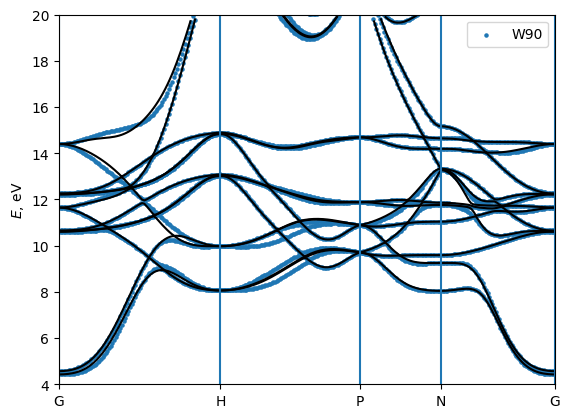
[9]:
# plot the bands and compare with wannier90
A = np.loadtxt(open("bands/Fe_bands_w90.dat","r"))
plt.scatter (A[:,0],A[:,1],s=5,label = "W90")
path_result.plot_path_fat( path,
quantity=None,
save_file="Fe_bands+w90.pdf",
Eshift=0,
Emin=4, Emax=20,
iband=None,
mode="fatband",
fatfactor=20,
cut_k=False,
close_fig=False,
show_fig=False,
label = "WB"
)
plt.legend()
plt.show()
plt.close()
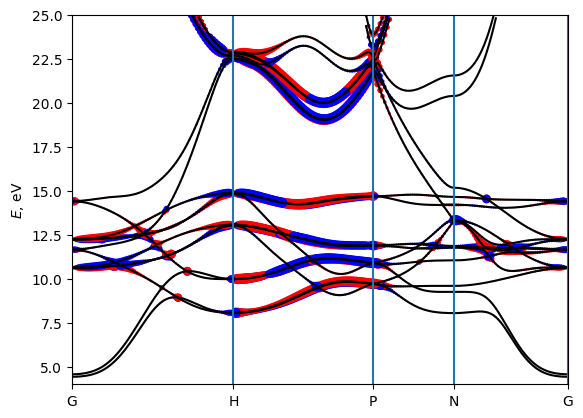
[10]:
# plot the Berry curvature
path_result.plot_path_fat( path,
quantity='berry_curvature',
component='z',
save_file=None, #"Fe_bands+berry.pdf",
Eshift=0,
Emin=4, Emax=25,
iband=None,
mode="fatband",
fatfactor=4,
cut_k=False,
close_fig=False,
show_fig=False,
)
plt.show()
plt.close()
# The size of the dots corresponds to the magnitude of BC on a logarithmic scale
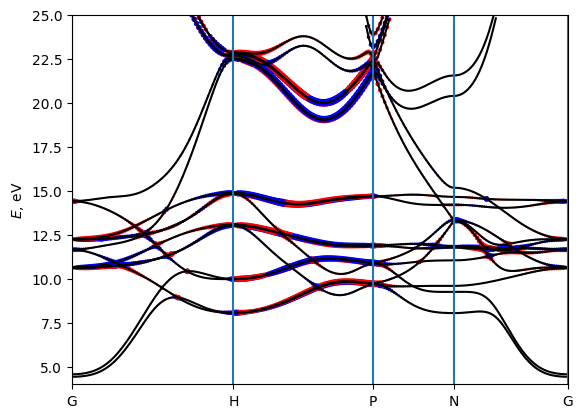
Problem 1:
modify the path
plot the “z” component of spin along it (without .
do not plot QE or W90 bands in this case
Hint : look here for a proper Calculator https://wannier-berri.org/docs/calculators.html#tabulating
[ ]:
# put the necessary code here
Get the data and do whatever you want
[11]:
k=path.getKline()
E=path_result.get_data(quantity='Energy',iband=(10,11))
curv=path_result.get_data(quantity='berry_curvature',iband=(10,11),component="z")
print (k.shape, E.shape, curv.shape)
(215,) (215, 2) (215, 2)
Calaculation on a 3D grid
Now let’s investigate how Berry curvature behaves in the 3D Brillouin zone. For that we need to set a grid, which can be done in several ways, see input parameters here
Most important to recall, is that in WB one sets two grids : the FFT grid and the K-grid (NKdiv). this is important for running the calculation. However, the final; result depends only on their product.
[12]:
# Set a grid
grid = wberri.Grid(system, length=50 ) # length [ Ang] ~= 2*pi/dk
#grid = wberri.Grid(system, NK=[24,24,24], NKFFT=4)
#grid = wberri.Grid(system, NKdiv=6, NKFFT=4)
Minimal symmetric FFT grid : [4 4 4]
We can use the same tabulators, but now we pack them into TabulatorAll in “grid” mode
[13]:
tabulators = { "Energy": wberri.calculators.tabulate.Energy(),
"berry_curvature" : wberri.calculators.tabulate.BerryCurvature(),
}
tab_all_grid = wberri.calculators.TabulatorAll(
tabulators,
ibands = np.arange(0,18),
mode = "grid"
)
And we run the calculation in the same way
[14]:
result=wberri.run(system,
grid=grid,
calculators = {"tabulate" : tab_all_grid},
print_Kpoints = True)
print (result.results)
grid_result = result.results["tabulate"]
Starting run()
Using the follwing calculators :
############################################################
'tabulate' : <wannierberri.calculators.tabulate.TabulatorAll object at 0x789088618dd0> :
TabulatorAll - a pack of all k-resolved calculators (Tabulators)
Includes the following tabulators :
--------------------------------------------------
"Energy" : <wannierberri.calculators.tabulate.Energy object at 0x789090153560> : calculator not described
"berry_curvature" : <wannierberri.calculators.tabulate.BerryCurvature object at 0x7890886dfad0> : calculator not described
--------------------------------------------------
############################################################
Calculation on grid - checking calculators for compatibility
tabulate <wannierberri.calculators.tabulate.TabulatorAll object at 0x789088618dd0>
All calculators are compatible
Grid is regular
The set of k points is a Grid() with NKdiv=[5 5 5], NKFFT=[5 5 5], NKtot=[25 25 25]
generating K_list
Done in 0.0007793903350830078 s
excluding symmetry-equivalent K-points from initial grid
Done in 0.009445905685424805 s
K_list contains 18 Irreducible points(14.4%) out of initial 5x5x5=125 grid
Done, sum of weights:1.0000000000000004
############################################################
Iteration 0 out of 0
iteration 0 - 18 points. New points are:
K-point 0 : coord in rec.lattice = [ 0.000000 , 0.000000 , 0.000000 ], refinement level:0, factor = 0.008dK=[0.2 0.2 0.2]
K-point 1 : coord in rec.lattice = [ 0.000000 , 0.200000 , 0.000000 ], refinement level:0, factor = 0.032dK=[0.2 0.2 0.2]
K-point 2 : coord in rec.lattice = [ 0.000000 , 0.400000 , 0.000000 ], refinement level:0, factor = 0.032dK=[0.2 0.2 0.2]
K-point 3 : coord in rec.lattice = [ 0.200000 , 0.000000 , 0.000000 ], refinement level:0, factor = 0.064dK=[0.2 0.2 0.2]
K-point 4 : coord in rec.lattice = [ 0.200000 , 0.200000 , 0.200000 ], refinement level:0, factor = 0.016dK=[0.2 0.2 0.2]
K-point 5 : coord in rec.lattice = [ 0.200000 , 0.600000 , 0.200000 ], refinement level:0, factor = 0.064dK=[0.2 0.2 0.2]
K-point 6 : coord in rec.lattice = [ 0.400000 , 0.000000 , 0.000000 ], refinement level:0, factor = 0.064dK=[0.2 0.2 0.2]
K-point 7 : coord in rec.lattice = [ 0.400000 , 0.200000 , 0.000000 ], refinement level:0, factor = 0.064dK=[0.2 0.2 0.2]
K-point 8 : coord in rec.lattice = [ 0.400000 , 0.200000 , 0.200000 ], refinement level:0, factor = 0.064dK=[0.2 0.2 0.2]
K-point 9 : coord in rec.lattice = [ 0.400000 , 0.400000 , 0.400000 ], refinement level:0, factor = 0.016dK=[0.2 0.2 0.2]
K-point 10 : coord in rec.lattice = [ 0.600000 , 0.200000 , 0.000000 ], refinement level:0, factor = 0.12800000000000006dK=[0.2 0.2 0.2]
K-point 11 : coord in rec.lattice = [ 0.600000 , 0.200000 , 0.200000 ], refinement level:0, factor = 0.064dK=[0.2 0.2 0.2]
K-point 12 : coord in rec.lattice = [ 0.600000 , 0.400000 , 0.200000 ], refinement level:0, factor = 0.064dK=[0.2 0.2 0.2]
K-point 13 : coord in rec.lattice = [ 0.600000 , 0.400000 , 0.400000 ], refinement level:0, factor = 0.032dK=[0.2 0.2 0.2]
K-point 14 : coord in rec.lattice = [ 0.800000 , 0.200000 , 0.000000 ], refinement level:0, factor = 0.12800000000000006dK=[0.2 0.2 0.2]
K-point 15 : coord in rec.lattice = [ 0.800000 , 0.200000 , 0.200000 ], refinement level:0, factor = 0.032dK=[0.2 0.2 0.2]
K-point 16 : coord in rec.lattice = [ 0.800000 , 0.400000 , 0.000000 ], refinement level:0, factor = 0.064dK=[0.2 0.2 0.2]
K-point 17 : coord in rec.lattice = [ 0.800000 , 0.400000 , 0.200000 ], refinement level:0, factor = 0.064dK=[0.2 0.2 0.2]
processing 18 K points : using 8 processes.
# K-points calculated Wall time (sec) Est. remaining (sec) Est. total (sec)
time for processing 18 K-points on 8 processes: 2.3408 ; per K-point 0.1300 ; proc-sec per K-point 1.0403
time1 = 0.012772083282470703
setting the grid
setting new kpoints
finding equivalent kpoints
collecting
collecting: to_grid : 0.09140300750732422
collecting: TABresult : 0.0006492137908935547
collecting - OK : 0.09207391738891602 (2.1696090698242188e-05)
Totally processed 18 K-points
run() finished
{'tabulate': <wannierberri.result.tabresult.TABresult object at 0x789088618860>}
Writing the FermiSurfer files
You may see that conversion to text format takes time. so convert only those components that you really need for plotting.
[15]:
grid_result.write_frmsf(name="Fe_grid", quantity="berry_curvature",
components="z",
)
Enk (25, 25, 25, 18)
using a pool of 32 processes to write txt frmsf of 489 points per process
using a pool of 32 processes to write txt frmsf of 489 points per process
using a pool of 32 processes to write txt frmsf of 489 points per process
using a pool of 32 processes to write txt frmsf of 489 points per process
using a pool of 32 processes to write txt frmsf of 489 points per process
using a pool of 32 processes to write txt frmsf of 489 points per process
using a pool of 32 processes to write txt frmsf of 489 points per process
using a pool of 32 processes to write txt frmsf of 489 points per process
using a pool of 32 processes to write txt frmsf of 489 points per process
using a pool of 32 processes to write txt frmsf of 489 points per process
using a pool of 32 processes to write txt frmsf of 489 points per process
using a pool of 32 processes to write txt frmsf of 489 points per process
using a pool of 32 processes to write txt frmsf of 489 points per process
using a pool of 32 processes to write txt frmsf of 489 points per process
using a pool of 32 processes to write txt frmsf of 489 points per process
using a pool of 32 processes to write txt frmsf of 489 points per process
using a pool of 32 processes to write txt frmsf of 489 points per process
using a pool of 32 processes to write txt frmsf of 489 points per process
Xnk (25, 25, 25, 18)
using a pool of 32 processes to write txt frmsf of 489 points per process
using a pool of 32 processes to write txt frmsf of 489 points per process
using a pool of 32 processes to write txt frmsf of 489 points per process
using a pool of 32 processes to write txt frmsf of 489 points per process
using a pool of 32 processes to write txt frmsf of 489 points per process
using a pool of 32 processes to write txt frmsf of 489 points per process
using a pool of 32 processes to write txt frmsf of 489 points per process
using a pool of 32 processes to write txt frmsf of 489 points per process
using a pool of 32 processes to write txt frmsf of 489 points per process
using a pool of 32 processes to write txt frmsf of 489 points per process
using a pool of 32 processes to write txt frmsf of 489 points per process
using a pool of 32 processes to write txt frmsf of 489 points per process
using a pool of 32 processes to write txt frmsf of 489 points per process
using a pool of 32 processes to write txt frmsf of 489 points per process
using a pool of 32 processes to write txt frmsf of 489 points per process
using a pool of 32 processes to write txt frmsf of 489 points per process
using a pool of 32 processes to write txt frmsf of 489 points per process
using a pool of 32 processes to write txt frmsf of 489 points per process
[15]:
(16.544941186904907, 0.01615738868713379)
[16]:
# Now we got some .frmsf files
!ls -al *.frmsf
# !rm *.frmsf
-rw-rw-r-- 1 stepan stepan 6592280 Nov 20 05:17 Fe_grid_berry_curvature-z.frmsf
[ ]:
# let's look at them using the Fermisurfer! (https://fermisurfer.osdn.jp/)
!fermisurfer Fe_grid_berry_curvature-z.frmsf
Analyze the tabulated data
[17]:
# You may get the data as numpy arrays via:
Energy = grid_result.get_data(iband=5, quantity='Energy')
ahc = grid_result.get_data(iband=5, quantity='berry_curvature',component='z')
print(ahc.shape,Energy.shape)
(25, 25, 25) (25, 25, 25)
Problem 2 :
fill the missing parts and evaluate the Berry curvature summed over all states below EF = 12.6 eV. Plot in on a plane k3=const (in reduced coordinates)
[18]:
# example : find the total Berry curvature of occupied states
# on the plane (k1,k2), k3=const (in reduced coordinates)
Berry_occ = 0
k3 = 9
EF=12.4
for ib in range(18):
Energy = grid_result.get_data(iband=ib, quantity='Energy')[:,:,k3]
ahc = grid_result.get_data(iband=ib, quantity='berry_curvature')[:,:,k3]
ahc [Energy>EF] = 0
Berry_occ += ahc
plt.contour(Energy,levels = [EF],linewidths=0.5,colors='black')
shw = plt.imshow(Berry_occ,vmin=-10,vmax=10,cmap="jet")
bar = plt.colorbar(shw)
Clipping input data to the valid range for imshow with RGB data ([0..1] for floats or [0..255] for integers). Got range [-6.647687113016109..51.15952635204786].
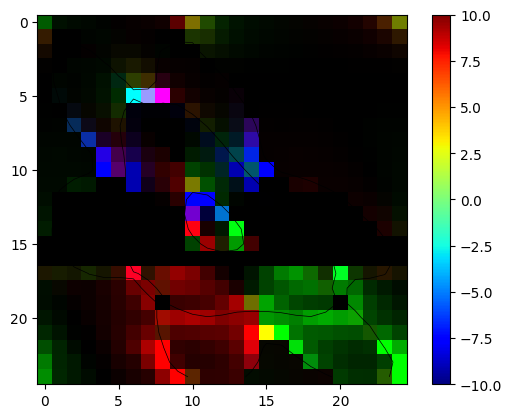
Integration on a grid: anomalous Hall conductivity
Now, after we saw that the Berry curvature changes rapidly in the k-space, we understand that to get the precise value of AHC (\ref{eq:ahc}) defined as a Fermi-sea integral of Berry curvature
\begin{equation} \sigma^{\rm AHC}_{xy} = -\frac{e^2}{\hbar} \sum_n^{\rm occ} \int\frac{d\mathbf{k}}{(2\pi)^3} \Omega^n_\gamma \label{eq:ahc}\tag{1} \end{equation}
we need a very dense grid. The calculation is done again, by using the calculators. AHC may be viewed as a function of the Fermi level. Such calculators are called StaticCalculator , because the corresponding effects can be measured in static fields. (as opposed to dynamic calculators, see below).
[19]:
calculators = {}
Efermi = np.linspace(12,13,101)
omega = np.linspace(0,1.,101)
# Set a grid
grid = wberri.Grid(system, length=50 ) # length [ Ang] ~= 2*pi/dk
calculators ["ahc"] = wberri.calculators.static.AHC(Efermi=Efermi)
result_run = wberri.run(system,
grid=grid,
calculators = calculators,
adpt_num_iter=5,
fout_name='Fe',
restart=False,
file_Klist="Klist_ahc.pickle" # needed to restart a calculation in future
)
Minimal symmetric FFT grid : [4 4 4]
Starting run()
Using the follwing calculators :
############################################################
'ahc' : <wannierberri.calculators.static.AHC object at 0x7890a409d430> : Anomalous Hall conductivity (:math:`s^3 \cdot A^2 / (kg \cdot m^3) = S/m`)
| With Fermi sea integral Eq(11) in `Ref <https://www.nature.com/articles/s41524-021-00498-5>`__
| Output: :math:`O = -e^2/\hbar \int [dk] \Omega f`
| Instruction: :math:`j_\alpha = \sigma_{\alpha\beta} E_\beta = \epsilon_{\alpha\beta\delta} O_\delta E_\beta`
############################################################
Calculation on grid - checking calculators for compatibility
ahc <wannierberri.calculators.static.AHC object at 0x7890a409d430>
All calculators are compatible
Grid is regular
The set of k points is a Grid() with NKdiv=[5 5 5], NKFFT=[5 5 5], NKtot=[25 25 25]
generating K_list
Done in 0.001283884048461914 s
excluding symmetry-equivalent K-points from initial grid
Done in 0.010955572128295898 s
K_list contains 18 Irreducible points(14.4%) out of initial 5x5x5=125 grid
Done, sum of weights:1.0000000000000004
############################################################
Iteration 0 out of 5
processing 18 K points : using 8 processes.
# K-points calculated Wall time (sec) Est. remaining (sec) Est. total (sec)
time for processing 18 K-points on 8 processes: 0.3678 ; per K-point 0.0204 ; proc-sec per K-point 0.1635
time1 = 0.00035381317138671875
time2 = 0.0018608570098876953
sum of weights now :1.0000000000000004
Writing file_Klist_factor_changed to Klist_ahc.changed_factors.txt
############################################################
Iteration 1 out of 5
processing 3 K points : using 8 processes.
# K-points calculated Wall time (sec) Est. remaining (sec) Est. total (sec)
time for processing 3 K-points on 8 processes: 0.1449 ; per K-point 0.0483 ; proc-sec per K-point 0.3864
time1 = 0.00015878677368164062
time2 = 0.00185394287109375
sum of weights now :1.0000000000000004
Writing file_Klist_factor_changed to Klist_ahc.changed_factors.txt
############################################################
Iteration 2 out of 5
processing 6 K points : using 8 processes.
# K-points calculated Wall time (sec) Est. remaining (sec) Est. total (sec)
time for processing 6 K-points on 8 processes: 0.1559 ; per K-point 0.0260 ; proc-sec per K-point 0.2079
time1 = 0.0004096031188964844
time2 = 0.0038251876831054688
sum of weights now :1.0000000000000004
Writing file_Klist_factor_changed to Klist_ahc.changed_factors.txt
############################################################
Iteration 3 out of 5
processing 12 K points : using 8 processes.
# K-points calculated Wall time (sec) Est. remaining (sec) Est. total (sec)
time for processing 12 K-points on 8 processes: 0.2884 ; per K-point 0.0240 ; proc-sec per K-point 0.1923
time1 = 0.0006458759307861328
time2 = 0.0040400028228759766
sum of weights now :1.0000000000000004
Writing file_Klist_factor_changed to Klist_ahc.changed_factors.txt
############################################################
Iteration 4 out of 5
processing 11 K points : using 8 processes.
# K-points calculated Wall time (sec) Est. remaining (sec) Est. total (sec)
time for processing 11 K-points on 8 processes: 0.3217 ; per K-point 0.0292 ; proc-sec per K-point 0.2339
time1 = 0.0002465248107910156
time2 = 0.0017385482788085938
sum of weights now :1.0000000000000002
Writing file_Klist_factor_changed to Klist_ahc.changed_factors.txt
############################################################
Iteration 5 out of 5
processing 4 K points : using 8 processes.
# K-points calculated Wall time (sec) Est. remaining (sec) Est. total (sec)
time for processing 4 K-points on 8 processes: 0.1930 ; per K-point 0.0482 ; proc-sec per K-point 0.3859
time1 = 0.0002067089080810547
Totally processed 54 K-points
run() finished
[ ]:
!ls
[20]:
#plot results from different iterations
#plot results from different iterations
for i in range(5):
res = np.load(f"Fe-ahc_iter-{i:04d}.npz")
# print (list(res.keys()))
ef = res["Energies_0"]
ahc_xy = res["data"][:,2]
# alternatively from text files:
# a = np.loadtxt(f"Fe-ahc_iter-{i:04d}.dat")
# ef = a[:,0]
# ahc_xy = a[:,3]
plt.plot(ef,ahc_xy,label = f"iteration-{i}")
#plt.ylim(-1000,1000)
plt.xlabel("E [eV]")
plt.ylabel("AHC (S/m)")
plt.legend()
plt.show()

[21]:
result_run = wberri.run(system,
grid=grid,
calculators = calculators,
adpt_num_iter=10,
fout_name='Fe',
restart=True,
file_Klist="Klist_ahc.pickle" # needed to restart a calculation
)
Starting run()
Using the follwing calculators :
############################################################
'ahc' : <wannierberri.calculators.static.AHC object at 0x7890a409d430> : Anomalous Hall conductivity (:math:`s^3 \cdot A^2 / (kg \cdot m^3) = S/m`)
| With Fermi sea integral Eq(11) in `Ref <https://www.nature.com/articles/s41524-021-00498-5>`__
| Output: :math:`O = -e^2/\hbar \int [dk] \Omega f`
| Instruction: :math:`j_\alpha = \sigma_{\alpha\beta} E_\beta = \epsilon_{\alpha\beta\delta} O_\delta E_\beta`
############################################################
Calculation on grid - checking calculators for compatibility
ahc <wannierberri.calculators.static.AHC object at 0x7890a409d430>
All calculators are compatible
Grid is regular
The set of k points is a Grid() with NKdiv=[5 5 5], NKFFT=[5 5 5], NKtot=[25 25 25]
Finished reading Klist from file Klist_ahc.pickle
54 K-points were read from Klist_ahc.pickle
9 K-points were read from Klist_ahc.changed_factors.txt
searching for start_iter
start_iter = 0
############################################################
Iteration 0 out of 10
nothing to process now
time1 = 0.004565238952636719
time2 = 0.0028028488159179688
sum of weights now :1.0000000000000002
Writing file_Klist_factor_changed to Klist_ahc.changed_factors.txt
############################################################
Iteration 1 out of 10
processing 11 K points : using 8 processes.
# K-points calculated Wall time (sec) Est. remaining (sec) Est. total (sec)
time for processing 11 K-points on 8 processes: 0.2864 ; per K-point 0.0260 ; proc-sec per K-point 0.2083
time1 = 0.0009737014770507812
time2 = 0.005987644195556641
sum of weights now :1.0
Writing file_Klist_factor_changed to Klist_ahc.changed_factors.txt
############################################################
Iteration 2 out of 10
processing 6 K points : using 8 processes.
# K-points calculated Wall time (sec) Est. remaining (sec) Est. total (sec)
time for processing 6 K-points on 8 processes: 0.2343 ; per K-point 0.0390 ; proc-sec per K-point 0.3123
time1 = 0.0004172325134277344
time2 = 0.0036897659301757812
sum of weights now :1.0
Writing file_Klist_factor_changed to Klist_ahc.changed_factors.txt
############################################################
Iteration 3 out of 10
processing 6 K points : using 8 processes.
# K-points calculated Wall time (sec) Est. remaining (sec) Est. total (sec)
time for processing 6 K-points on 8 processes: 0.2822 ; per K-point 0.0470 ; proc-sec per K-point 0.3763
time1 = 0.0006368160247802734
time2 = 0.005970001220703125
sum of weights now :1.0
Writing file_Klist_factor_changed to Klist_ahc.changed_factors.txt
############################################################
Iteration 4 out of 10
processing 13 K points : using 8 processes.
# K-points calculated Wall time (sec) Est. remaining (sec) Est. total (sec)
time for processing 13 K-points on 8 processes: 0.3156 ; per K-point 0.0243 ; proc-sec per K-point 0.1942
time1 = 0.0008323192596435547
time2 = 0.004408597946166992
sum of weights now :1.0
Writing file_Klist_factor_changed to Klist_ahc.changed_factors.txt
############################################################
Iteration 5 out of 10
processing 11 K points : using 8 processes.
# K-points calculated Wall time (sec) Est. remaining (sec) Est. total (sec)
time for processing 11 K-points on 8 processes: 0.3089 ; per K-point 0.0281 ; proc-sec per K-point 0.2246
time1 = 0.00047397613525390625
time2 = 0.003819704055786133
sum of weights now :1.0
Writing file_Klist_factor_changed to Klist_ahc.changed_factors.txt
############################################################
Iteration 6 out of 10
processing 7 K points : using 8 processes.
# K-points calculated Wall time (sec) Est. remaining (sec) Est. total (sec)
time for processing 7 K-points on 8 processes: 0.2456 ; per K-point 0.0351 ; proc-sec per K-point 0.2807
time1 = 0.0004699230194091797
time2 = 0.003711700439453125
sum of weights now :1.0
Writing file_Klist_factor_changed to Klist_ahc.changed_factors.txt
############################################################
Iteration 7 out of 10
processing 13 K points : using 8 processes.
# K-points calculated Wall time (sec) Est. remaining (sec) Est. total (sec)
time for processing 13 K-points on 8 processes: 0.3091 ; per K-point 0.0238 ; proc-sec per K-point 0.1902
time1 = 0.0003952980041503906
time2 = 0.002221345901489258
sum of weights now :1.0000000000000002
Writing file_Klist_factor_changed to Klist_ahc.changed_factors.txt
############################################################
Iteration 8 out of 10
processing 15 K points : using 8 processes.
# K-points calculated Wall time (sec) Est. remaining (sec) Est. total (sec)
time for processing 15 K-points on 8 processes: 0.3476 ; per K-point 0.0232 ; proc-sec per K-point 0.1854
time1 = 0.0007455348968505859
time2 = 0.004282236099243164
sum of weights now :1.0000000000000004
Writing file_Klist_factor_changed to Klist_ahc.changed_factors.txt
############################################################
Iteration 9 out of 10
processing 17 K points : using 8 processes.
# K-points calculated Wall time (sec) Est. remaining (sec) Est. total (sec)
time for processing 17 K-points on 8 processes: 0.4693 ; per K-point 0.0276 ; proc-sec per K-point 0.2209
time1 = 0.0008656978607177734
time2 = 0.004148006439208984
sum of weights now :1.0000000000000009
Writing file_Klist_factor_changed to Klist_ahc.changed_factors.txt
############################################################
Iteration 10 out of 10
processing 9 K points : using 8 processes.
# K-points calculated Wall time (sec) Est. remaining (sec) Est. total (sec)
time for processing 9 K-points on 8 processes: 0.3254 ; per K-point 0.0362 ; proc-sec per K-point 0.2892
time1 = 0.0009763240814208984
Totally processed 108 K-points
run() finished
[22]:
#plot results from different iterations
for i in range(10,15):
res = np.load(f"Fe-ahc_iter-{i:04d}.npz")
# print (list(res.keys()))
ef = res["Energies_0"]
ahc_xy = res["data"][:,2]
# alternatively from text files:
# a = np.loadtxt(f"Fe-ahc_iter-{i:04d}.dat")
# ef = a[:,0]
# ahc_xy = a[:,3]
plt.plot(ef,ahc_xy,label = f"iteration-{i}")
#plt.ylim(-1000,1000)
plt.xlabel("E [eV]")
plt.ylabel("AHC (S/m)")
plt.legend()
plt.show()

Problem 3 :
start from a denser grid (length=100 or 200) and do the integration again with 20 iterations. Plot the results
[ ]:
# insert the needed code below
Tetrahedron method
[23]:
calculators = {}
Efermi = np.linspace(12,13,101)
omega = np.linspace(0,1.,101)
# Set a grid
grid = wberri.Grid(system, length=50 ) # length [ Ang] ~= 2*pi/dk
calculators ["dos_notetra"] = wberri.calculators.static.DOS(Efermi=Efermi,tetra=False)
calculators ["dos_tetra"] = wberri.calculators.static.DOS(Efermi=Efermi,tetra=True)
result_run = wberri.run(system,
grid=grid,
calculators = calculators,
adpt_num_iter=0,
fout_name='Fe',
suffix = "run2",
restart=False,
print_Kpoints=False
)
a = np.loadtxt(f"Fe-dos_notetra-run2_iter-0000.dat")
plt.plot(a[:,0],a[:,1],label = f"no tetra")
a = np.loadtxt(f"Fe-dos_tetra-run2_iter-0000.dat")
plt.plot(a[:,0],a[:,1],label = f"tetra")
plt.legend()
Minimal symmetric FFT grid : [4 4 4]
Starting run()
Using the follwing calculators :
############################################################
'dos_notetra' : <wannierberri.calculators.static.DOS object at 0x78908857d7f0> : Density of states
'dos_tetra' : <wannierberri.calculators.static.DOS object at 0x78908857ed20> : Density of states
############################################################
Calculation on grid - checking calculators for compatibility
dos_notetra <wannierberri.calculators.static.DOS object at 0x78908857d7f0>
dos_tetra <wannierberri.calculators.static.DOS object at 0x78908857ed20>
All calculators are compatible
Grid is regular
The set of k points is a Grid() with NKdiv=[5 5 5], NKFFT=[5 5 5], NKtot=[25 25 25]
generating K_list
Done in 0.0017361640930175781 s
excluding symmetry-equivalent K-points from initial grid
Done in 0.010408401489257812 s
K_list contains 18 Irreducible points(14.4%) out of initial 5x5x5=125 grid
Done, sum of weights:1.0000000000000004
############################################################
Iteration 0 out of 0
processing 18 K points : using 8 processes.
# K-points calculated Wall time (sec) Est. remaining (sec) Est. total (sec)
8 5.1 6.4 11.5
time for processing 18 K-points on 8 processes: 5.4066 ; per K-point 0.3004 ; proc-sec per K-point 2.4029
time1 = 0.0009217262268066406
Totally processed 18 K-points
run() finished
[23]:
<matplotlib.legend.Legend at 0x7890885d4fe0>
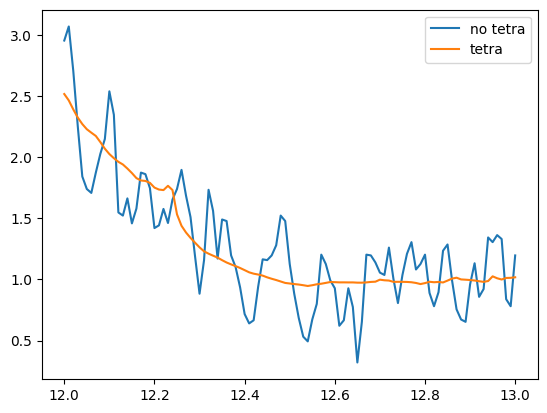
[ ]:
!ls
Optical conductivity
[24]:
calculators = {}
Efermi = np.linspace(12,13,101)
omega = np.linspace(0,1.,101)
# Set a grid
grid = wberri.Grid(system, length=50 ) # length [ Ang] ~= 2*pi/dk
calculators["opt_conductivity"] = wberri.calculators.dynamic.OpticalConductivity(
Efermi=Efermi,omega=omega)
result_run_opt = wberri.run(system,
grid=grid,
calculators = calculators,
adpt_num_iter=0,
fout_name='Fe',
suffix = "run3",
restart=False,
)
Minimal symmetric FFT grid : [4 4 4]
Starting run()
Using the follwing calculators :
############################################################
'opt_conductivity' : <wannierberri.calculators.dynamic.OpticalConductivity object at 0x7890881efec0> : calculator not described
############################################################
Calculation on grid - checking calculators for compatibility
opt_conductivity <wannierberri.calculators.dynamic.OpticalConductivity object at 0x7890881efec0>
All calculators are compatible
Grid is regular
The set of k points is a Grid() with NKdiv=[5 5 5], NKFFT=[5 5 5], NKtot=[25 25 25]
generating K_list
Done in 0.0007431507110595703 s
excluding symmetry-equivalent K-points from initial grid
Done in 0.009906768798828125 s
K_list contains 18 Irreducible points(14.4%) out of initial 5x5x5=125 grid
Done, sum of weights:1.0000000000000004
############################################################
Iteration 0 out of 0
processing 18 K points : using 8 processes.
# K-points calculated Wall time (sec) Est. remaining (sec) Est. total (sec)
16 5.9 0.7 6.6
time for processing 18 K-points on 8 processes: 7.3230 ; per K-point 0.4068 ; proc-sec per K-point 3.2547
time1 = 0.015322685241699219
Totally processed 18 K-points
run() finished
[25]:
#plot results from new iterations
res = result_run_opt.results["opt_conductivity"]
print (res.data.shape)
print (res.Energies[0]) # Efermi
print (res.Energies[1]) # omega
# plot at fixed omega
iw = 10
plt.plot(res.Energies[0], res.data[:,iw,2,2].imag)
plt.show()
# plot at fixed Efermi
ief = 20
plt.plot(res.Energies[1], res.data[ief,:,2,2].imag)
plt.show()
(101, 101, 3, 3)
[12. 12.01 12.02 12.03 12.04 12.05 12.06 12.07 12.08 12.09 12.1 12.11
12.12 12.13 12.14 12.15 12.16 12.17 12.18 12.19 12.2 12.21 12.22 12.23
12.24 12.25 12.26 12.27 12.28 12.29 12.3 12.31 12.32 12.33 12.34 12.35
12.36 12.37 12.38 12.39 12.4 12.41 12.42 12.43 12.44 12.45 12.46 12.47
12.48 12.49 12.5 12.51 12.52 12.53 12.54 12.55 12.56 12.57 12.58 12.59
12.6 12.61 12.62 12.63 12.64 12.65 12.66 12.67 12.68 12.69 12.7 12.71
12.72 12.73 12.74 12.75 12.76 12.77 12.78 12.79 12.8 12.81 12.82 12.83
12.84 12.85 12.86 12.87 12.88 12.89 12.9 12.91 12.92 12.93 12.94 12.95
12.96 12.97 12.98 12.99 13. ]
[0. 0.01 0.02 0.03 0.04 0.05 0.06 0.07 0.08 0.09 0.1 0.11 0.12 0.13
0.14 0.15 0.16 0.17 0.18 0.19 0.2 0.21 0.22 0.23 0.24 0.25 0.26 0.27
0.28 0.29 0.3 0.31 0.32 0.33 0.34 0.35 0.36 0.37 0.38 0.39 0.4 0.41
0.42 0.43 0.44 0.45 0.46 0.47 0.48 0.49 0.5 0.51 0.52 0.53 0.54 0.55
0.56 0.57 0.58 0.59 0.6 0.61 0.62 0.63 0.64 0.65 0.66 0.67 0.68 0.69
0.7 0.71 0.72 0.73 0.74 0.75 0.76 0.77 0.78 0.79 0.8 0.81 0.82 0.83
0.84 0.85 0.86 0.87 0.88 0.89 0.9 0.91 0.92 0.93 0.94 0.95 0.96 0.97
0.98 0.99 1. ]
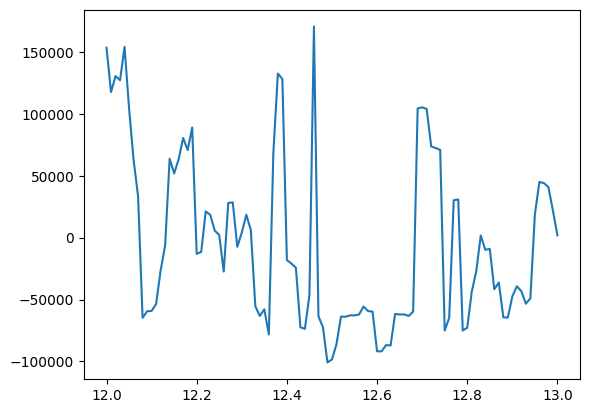
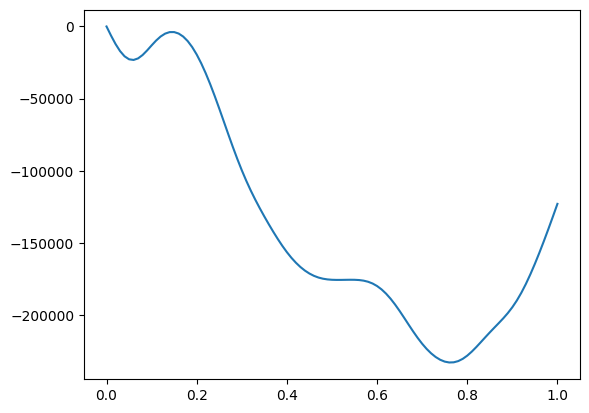
[ ]:
!ls
All in one
[26]:
calculators = {}
Efermi = np.linspace(12,13,101)
omega = np.linspace(0,1.,101)
# Set a grid
grid = wberri.Grid(system, length=50 ) # length [ Ang] ~= 2*pi/dk
calculators ["ahc_notetra"] = wberri.calculators.static.AHC(Efermi=Efermi,tetra=False)
calculators ["ahc_tetra"] = wberri.calculators.static.AHC(Efermi=Efermi,tetra=True)
calculators ["tabulate"] = wberri.calculators.TabulatorAll({
"Energy":wberri.calculators.tabulate.Energy(),
"berry":wberri.calculators.tabulate.BerryCurvature(),
},
ibands = np.arange(4,10))
calculators["opt_conductivity"] = wberri.calculators.dynamic.OpticalConductivity(
Efermi=Efermi,omega=omega)
result_run = wberri.run(system,
grid=grid,
calculators = calculators,
adpt_num_iter=0,
fout_name='Fe',
suffix = "run",
restart=False,
)
Minimal symmetric FFT grid : [4 4 4]
Starting run()
Using the follwing calculators :
############################################################
'ahc_notetra' : <wannierberri.calculators.static.AHC object at 0x78908857ed20> : Anomalous Hall conductivity (:math:`s^3 \cdot A^2 / (kg \cdot m^3) = S/m`)
| With Fermi sea integral Eq(11) in `Ref <https://www.nature.com/articles/s41524-021-00498-5>`__
| Output: :math:`O = -e^2/\hbar \int [dk] \Omega f`
| Instruction: :math:`j_\alpha = \sigma_{\alpha\beta} E_\beta = \epsilon_{\alpha\beta\delta} O_\delta E_\beta`
'ahc_tetra' : <wannierberri.calculators.static.AHC object at 0x7890881ee210> : Anomalous Hall conductivity (:math:`s^3 \cdot A^2 / (kg \cdot m^3) = S/m`)
| With Fermi sea integral Eq(11) in `Ref <https://www.nature.com/articles/s41524-021-00498-5>`__
| Output: :math:`O = -e^2/\hbar \int [dk] \Omega f`
| Instruction: :math:`j_\alpha = \sigma_{\alpha\beta} E_\beta = \epsilon_{\alpha\beta\delta} O_\delta E_\beta`
'tabulate' : <wannierberri.calculators.tabulate.TabulatorAll object at 0x78908813a0c0> :
TabulatorAll - a pack of all k-resolved calculators (Tabulators)
Includes the following tabulators :
--------------------------------------------------
"Energy" : <wannierberri.calculators.tabulate.Energy object at 0x78908857c7d0> : calculator not described
"berry" : <wannierberri.calculators.tabulate.BerryCurvature object at 0x7890884a9190> : calculator not described
--------------------------------------------------
'opt_conductivity' : <wannierberri.calculators.dynamic.OpticalConductivity object at 0x789088428dd0> : calculator not described
############################################################
Calculation on grid - checking calculators for compatibility
ahc_notetra <wannierberri.calculators.static.AHC object at 0x78908857ed20>
ahc_tetra <wannierberri.calculators.static.AHC object at 0x7890881ee210>
tabulate <wannierberri.calculators.tabulate.TabulatorAll object at 0x78908813a0c0>
opt_conductivity <wannierberri.calculators.dynamic.OpticalConductivity object at 0x789088428dd0>
All calculators are compatible
Grid is regular
The set of k points is a Grid() with NKdiv=[5 5 5], NKFFT=[5 5 5], NKtot=[25 25 25]
generating K_list
Done in 0.0007631778717041016 s
excluding symmetry-equivalent K-points from initial grid
Done in 0.009635448455810547 s
K_list contains 18 Irreducible points(14.4%) out of initial 5x5x5=125 grid
Done, sum of weights:1.0000000000000004
############################################################
Iteration 0 out of 0
processing 18 K points : using 8 processes.
# K-points calculated Wall time (sec) Est. remaining (sec) Est. total (sec)
16 7.0 0.9 7.8
time for processing 18 K-points on 8 processes: 9.2311 ; per K-point 0.5128 ; proc-sec per K-point 4.1027
time1 = 0.018211841583251953
setting the grid
setting new kpoints
finding equivalent kpoints
collecting
collecting: to_grid : 0.07984185218811035
collecting: TABresult : 0.0006926059722900391
collecting - OK : 0.08055663108825684 (2.2172927856445312e-05)
Totally processed 18 K-points
run() finished
[ ]: